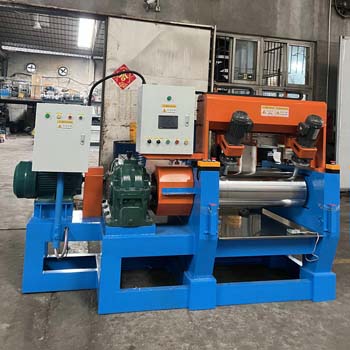Laboratory Mixing mills play a vital role in the rubber,silicone,chemical and plastic industries, especially in compounding, shearing, and thermal mixing. With the market for the demand for precision control and energy efficiency growing, double frequency laboratory mixing mills is developed based on tradition single frequency open mixing mill equipment.
But what exactly double frequency open mixing mill and how do they affect the performance of your mill? In this blog, let us compare the difference between double frequency lab mixing mill and single frequency lab mixing mill , their specific functions, and advantages of both configurations ,so that you can choose the better one lab mixing equipment as per your specific needs .
1. What Is a Single Frequency Mixing Mill?
Traditionaly , single frequency laboratory mixing mill is just equipped with one inverter (frequency converter) , which just controls the main motor—usually driving both rollers simultaneously. The friction ratio of two rolls are fixed but unable to be adjusted, and it is determined by the mechanical gear system.
While , double frequency laboratory mixing mill is a two-roll mixing mill equipped with two separate frequency inverters, which allow independent speed control of the front and rear rollers separately.
Therefore , double frequency laboratory mixing mill allow users to independently control and adjust the friction ratio , and the speed of the front and rear roller speeds separately , which is crucial for controlling the shearing force during the mixing process.
✅ Features of Single Frequency Laboratory Mixing Mill Equipment:
* Fixed speed ratio between the two rollers
* Simpler electrical structure
* Lower cost and easier maintenance
* Typically used in standard rubber and plastic compounding
🚩 Limitations of Single Frequency Laboratory Mixing Mill Equipment:
* Cannot adjust the friction ratio
* Less flexibility in adjusting processing parameters
* Not ideal for materials that require precise control over shearing force
✅ Features of Double Frequency Laboratory Mixing Mill Equipment:
* The friction ratio of two roll can be adjustable (e.g., 1:1.1 ~ 1:1.5)
* Double frequency mixing mill enhanced mixing control for specialty materials
* Double frequency two roll mill can be equipped PLC + HMI interface for real-time parameter setting
* Basically ,double frequency lab mixing mills machine are suitable for lab R&D in research center, high-end rubber, and sensitive plastic materials
🚀 Advantages of Double Frequency Laboratory Mixing Mill Equipment:
* Double frequency style are more flexible to optimize shear rate for different materials
* It provide better compound quality and dispersion
* Basically ,double frequency equipment are ideal for formulation testing, small-scale pilot production, and advanced rubber processing
3. Which One Should You Choose?
✅ Choose Single Frequency Mixing Mill if:
* When you need to process regular rubber or plastic materials
* Limited by your budget and perfer a cost-effective solution
* The mixing process of your material does not need adjustment of friction frequently.
✅ Choose Double Frequency Mixing Mill if:
* When you need special formulations or sensitive polymers
* You want to control over compound behavior
* You need to process experiments for small-batch trials with varying process conditions
Therefore , the difference between single and double frequency mixing mills mainly rely on the control, flexibility, and process accuracy they offer. Generally , single frequency mills are practical for standard mixing tasks, while double frequency mixing mill machines bring precision and versatility, especially valued in R&D labs and high-performance rubber production.







